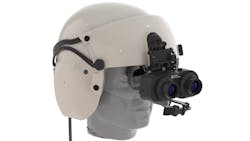Night missions are strongly impacted by vision effectiveness and the U.S. Navy and Marine Corps are hoping that a switch from analog to digital night-vision systems will increase their mission effectiveness. They are working with Collins Aerospace Systems (a unit of Raytheon Technologies) and the company’s Enhanced Visual Acuity (EVA) system to provide warfighters on rotary-wing and tiltrotor aircraft with significantly improved night vision.
The EVA system is currently being designed and prototyped as part of a developmental contract, with work being conducted at the company’s facilities in Iowa, Massachusetts, and California and expected to be completed by March 2023. The EVA system consists of a helmet-mounted binocular display (see the figure) that provides improved night vision at very low light levels (VLLL). The helmet is being designed to a streamlined architecture and light-weight components to minimize the strain on a pilot’s head and reduce fatigue when using the night-vision equipment.
“Digital night vision is a big step forward in providing enhanced situational awareness to the warfighter, and is a foundation we'll continually build on to ensure mission success,” said Dave Schreck, vice-president and general manager for Military Avionics and Helicopters at Collins Aerospace Systems. “Collins Aerospace is proud to deliver the capability provided by EVA as it will be a significant force multiplier for rotary-wing and tiltrotor aircrews.”
About the Author
Jack Browne
Technical Contributor
Jack Browne, Technical Contributor, has worked in technical publishing for over 30 years. He managed the content and production of three technical journals while at the American Institute of Physics, including Medical Physics and the Journal of Vacuum Science & Technology. He has been a Publisher and Editor for Penton Media, started the firm’s Wireless Symposium & Exhibition trade show in 1993, and currently serves as Technical Contributor for that company's Microwaves & RF magazine. Browne, who holds a BS in Mathematics from City College of New York and BA degrees in English and Philosophy from Fordham University, is a member of the IEEE.
